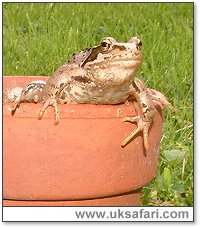
|

|
|
 Sent
to you Sent
to you
by e-mail
|
|
Simply
enter your details and hit the send button
more
info |
|


Click Here

Links
Advertise
Terms of Use
Contributors
About Us
Contact Us
|
 |
Go back
 | Bookmark
| Bookmark
 | Print Page
| Print Page  | E-Mail Us
| E-Mail Us 



Photo: G. Bradley |
|
UK
Safari Tip:
If your containers dry out in hot weather, and the plants wilt, a simple
remedy is to immerse the whole pot in warm water
until no air bubbles appear, and then leave it in a shady spot to recover.
|
|
Even if you don't have a large garden, you can still attract wildlife to your area using potted
wild flowers.
Container gardening is ideal for the urban naturalist trying to create a
colourful and inviting area. Following a few simple guidelines will result in
healthy attractive plants which will encourage wildlife to visit.
1) Choosing a container
Plan the type of plants you want to grow. The size and shape of the root system
and the growth rate need to be considered when choosing the container. Large
pots stay moist longer, are less subject to temperature changes, and allow for
more root growth. They can also accommodate more than one plant for added
variety. Hanging baskets dry out faster, and will need regular watering. Make
sure the container has drainage holes in the base. This will prevent the roots
of your plants from becoming water-logged, which can lead to root rot.
2) Choosing your plants
In many cases, local native plants will be stronger than non-native plants, and
will attract native butterflies, and other pollinating insects. During the
winter months, some plants will need to be moved to a sheltered location. If
plants are combined in one pot, be sure that their growing conditions and growth
forms are compatible.
3) Planting
Normal garden soil can be too dense, so use a houseplant soil mixture. To help
keep the soil cool and moist, put a layer of mulch on top.
4) Maintaining
The moisture of the soil should be checked frequently, both at the edge and the
centre of the pot. In cooler months, allow the plant to nearly dry out between
watering. When the temperature is higher, water daily. Watering is best done
early in the morning when it is cool. Pour the water directly onto the soil
rather than on the plant, as this can affect the growth.

UK Safari Gardening for Wildlife Section
|
 |

|